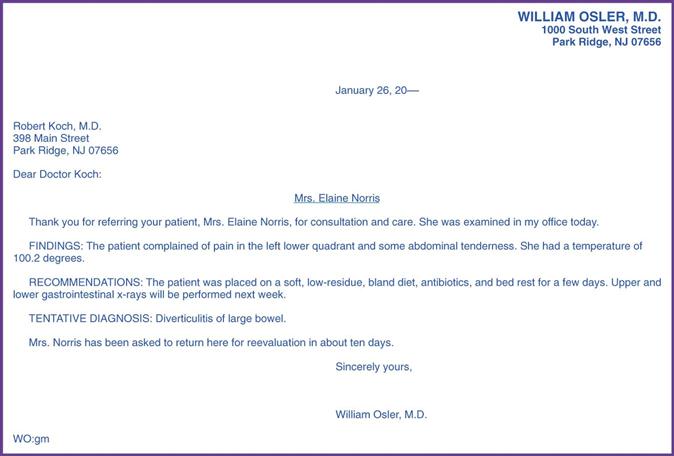1. Define, spell, and pronounce the terms listed in the vocabulary. 2. Recognize the elements of fundamental writing skills. 3. Explain the various parts of speech. 4. Name some essential references for the medical assistant’s library. 5. Discuss applications of electronic technology in effective communication. 6. List the four common sizes of letterhead stationery. 7. Discuss the differences in the four letter styles. 8. Explain the four standard parts of a business letter. 9. Discuss the process of developing and the value of keeping a communications portfolio. 10. Discuss how to open, sort, and annotate incoming mail. 11. Explain how to save money when mailing. 12. Describe how to compose, proofread, and mail a business letter. 13. Organize technical information and summaries. 14. Describe the proper way to send a fax. 15. Explain how to process incoming mail. academic degree A title conferred by a college, university, or professional school upon completion of a program of study. amiable (a′-me-uh-buhl) Having qualities that make one liked and easy to deal with. annotating Furnishing with notes that are usually critical or explanatory. archived To have filed or collected records or documents. bond A durable, formal paper used for documents. categorically Placed in a specific division of a system of classification. collect on delivery (COD) A method of payment used when an article or item is delivered and payment is expected before it is released. concise (kun-sis′) Expressing much in brief form. condescending Assuming an air of superiority. continuation pages The second and following pages of a letter. curt Marked by rude or peremptory shortness. disseminate (di-se′-muh-nat) To disperse throughout. domestic mail Mail sent within the boundaries of the United States and its territories. girth A measure around a body or an item. international mail Mail that is sent outside the boundaries of the United States and its territories. intrinsic (in-trin′-zik) Belonging to the essential nature or constitution of a thing; indwelling, inward. phrases Groups of words with a specific grammatical function, such as a noun phrase or an adjective phrase. ream A quantity of paper weighing 20 lb or consisting of, variously, 480, 500, or 516 sheets. recipient The receiver of some thing or item. stationers (sta′-shuh-nerz) Sellers of stationery. substance number A number based on the weight of a ream of paper containing 500 sheets. superfluous (suh-puhr′-flu-uhs) Exceeding what is sufficient or necessary. template Something that establishes or serves as a pattern. Brandon Tipps is a medical assistant who works with his father, Dr. Rick Tipps. Brandon has considered continuing his education to become a doctor, but he is not sure whether he would like to be a medical doctor, an osteopathic physician, or a chiropractor. He decided to spend his summer off from college working in his father’s family practice so that he can get a closer look at the inner workings of a physician’s office. Brandon has assisted with every procedure in the clinic, including the administrative skills required in the front office. The staff has been impressed with Brandon’s ability to do any task, no matter how small, as if it were the most important task in the office. He continuously moves from employee to employee to ask what he can do to help. When the administrative medical assistant working in the front office, Darla Grover, was injured in a car accident and had to be off work for a while, Brandon stepped right in to do her job and quickly learned her duties. His help enabled the office to continue to run smoothly even with one employee absent for several weeks. Brandon has an excellent command of the English language and types about 60 words per minute. Because he is organized and efficient, he can handle the enormous amount of incoming and outgoing mail with very little assistance from the office manager. He also is able to answer phones and schedule appointments. He speaks clearly and is an expert in customer service. Many of Dr. Tipps’ patients have known Brandon since he was a small child, and they enjoy seeing him helping in his father’s office. The patients and staff alike will certainly miss him once he returns to college. While studying this chapter, think about the following questions: Written correspondence and mail processing consume a large part of the day of the administrative medical assistant. When asked what skills they most want in an administrative assistant, many physicians specify the ability to spell accurately and to write a good letter. When a physician delegates the responsibility for composing letters or reports with the potential to reflect positively or negatively on the practice, he or she is expressing confidence in the medical assistant’s abilities. Written communications offer the perfect opportunity for making a good impression on others. However, communications that make such an impression do not just happen; they require thought, preparation, skill, and a positive attitude. Written communications include original letters, memorandums, replies to inquiries, responses to requests for information, telephone messages, e-mail, transcriptions, orders for supplies, instructions for patients, and a variety of other forms. Communications that are courteous to the reader, correct in content, and concise without being curt are most appreciated. Remember that people may misjudge the “tone” of an e-mail and determine that the sender was rude or hateful, when the sender may have just been very direct and pointed. Communication truly is both an art and a skill. The ability to communicate effectively is extremely important to the administrative medical assistant who wants to succeed and advance his or her career. Each member of the staff must be conscientious about the documents and materials in the office and those that leave it. An envelope addressed carelessly or a patient information sheet that has been photocopied over and over implies that the office staff is not concerned about the appearance of documents that leave the office. If the staff is careless in this respect, many patients assume the staff is careless with everything, including patient care. Everything that happens in the medical office reflects on the physician or physicians who practice there. Letters with misspelled words or errors give the reader a negative impression of the physician and the practice itself. Great care must be taken to ensure that each document in the office and sent from the office is well written and grammatically correct. Table 13-1 lists some frequently misspelled and misused words. For a list of more misspelled medical words, visit the Evolve site at evolve.elsevier.com/kinn. TABLE 13-1 150 Frequently Misspelled or Misused English Words All medical assistants must know the fundamental skills of proper business writing. Most business letters should be less than one page long and carefully organized (Procedure 13-1). This takes practice and preparation. Everyone who writes letters develops a personal style. The medical assistant should carefully read the letter to be answered. Make note of or underline any questions asked or materials requested. Decide on the answers to the questions and verify the information; this is called annotating. Draft a reply, proofread it, and then rewrite for clarity (Procedure 13-2). Keep most sentences short. Put only one idea in each sentence and eliminate superfluous words. Be careful about using medical terms in correspondence with patients. Instead, use language the reader can easily understand. Most physicians use a highly professional and formal style in their dictation. The medical assistant responsible for composing correspondence for the office should strive for the same degree of formality the physician uses. It would be inappropriate for the assistant to write in a breezy, informal style when acting as the representative of an employer with a more formal approach. The principal point to remember is that every letter produced in your office should project the image of the physician, regardless of who composes or signs the letter. Good grammar is essential to the writing of effective, professional business letters. Medical assistants must understand the elements of acceptable grammar and writing skills. A noun is a person, place, or thing. Nouns can also be thoughts, ideas, or concepts, such as freedom or courage. Common nouns name general persons, places, or things (e.g., teacher and city). Proper nouns are specific (e.g., Mrs. Adams and New York City). Pronouns replace nouns and provide the writer with shortcuts so that proper nouns do not have to be repeated constantly. Pronouns include words such as it, you, he, she, her, his, them, mine, you, yours, its, ours, and theirs. Action verbs are words that express movement, such as run, drive, or type. Linking verbs express a condition or state of being; they include is, am, are, was, be, and been. Linking verbs also express the senses, as in smell, hear, taste, touch, feel, and look. Adjectives can describe nouns and pronouns, or they may show which one, how many, and what kind of. A, an, and the are special types of adjectives called articles. Examples of adjectives include a golden sunset, a playful dog, and a crooked nose. Just as adjectives describe nouns, adverbs describe verbs, adjectives, or other adverbs. Adverbs specify when, where, to what extent, or how. Examples include unusually warm, never won, and quite cold. Connecting words that show a relationship between nouns, pronouns, or other words in a sentence are called prepositions. Examples of prepositions include by, from, of, to, in, at, with, into, and on. Conjunctions join words or phrases. These helpful words include and, or, nor, and but. Interjections show strong feeling. They often are followed by an exclamation point and sometimes by a comma. “Ouch! That really hurt!” is a sentence that uses an interjection. Sentence structure is important when writing a professional letter or document. Medical assistants should know the basics of good sentence structure so that written documents make sense and represent the medical facility and staff in a positive way. The four basic types of sentences are declarative, interrogatory, imperative, and exclamatory. Declarative sentences make a statement, whereas interrogatory sentences ask a question. Imperative sentences state a command or request. Exclamatory sentences express strong feeling. When written correctly, sentences follow certain patterns. Three very basic patterns are used to construct sentences: The subject of a sentence usually is a noun; it is the word or group of words that acts, or that is acted on or described by the verb. The predicate is the part of the sentence that contains the verb; it tells what the subject is doing or experiencing, or what is being done to the subject. The object is a noun, pronoun, or group of words functioning as a noun or pronoun that receives the action of the verb. The complement is a word or group of words in the predicate that renames or describes a subject or object in the sentence. Three main sentence errors plague most writers: the sentence fragment, the run-on sentence, and the comma splice. A sentence fragment is an incomplete thought or a part of a sentence that is punctuated as though it were a complete sentence: Although the doctor had seen the patient. A run-on sentence contains independent clauses that do not have a semicolon, a comma, or a conjunction between them. These are also called run-together or fused sentences: The office was clean when the staff left on Friday the doors were locked. A comma splice is a sentence in which a comma alone joins independent clauses: The storm grew worse, it began to snow. Competent handling of written communications requires a basic knowledge of composition. A personal reference library that includes an up-to-date standard dictionary, a medical dictionary, a composition handbook, an English language reference manual, and a thesaurus is a tremendous help. Those who have difficulty with spelling should keep a small, loose-leaf, indexed notebook or card index of troublesome words. If you need to look up the spelling of a word in the dictionary, record the word in the notebook or card index for quick reference. The physician or a medical assistant familiar with the practice might compile a basic list of frequently used medical terms and abbreviations as a reference. To create a favorable impression with letters, the medical assistant must use good equipment and high-quality supplies. Regardless of the kind of equipment available, the medical assistant is responsible for knowing how to use it to the best advantage and how to keep it in good working condition. If the equipment manual is available, study it and keep it handy for reference when problems occur. Know how to maintain equipment so that the effort invested in composing correspondence has a high-quality appearance. Computer applications and electronic technology have made all types of communication easy, efficient, and effective. Various letters and documents can be saved and reused time after time by changing the name and the basic information in the text. Computers can add graphics to text, compute figures, and use multimedia in communications, all of which enhance the document’s appearance and effectiveness. Maintain the copier so that copies are crisp and clear. The toner cartridge must be replaced or refilled when necessary, and this can be expensive. Multiple copies of documents usually are made on a copier rather than printed from the computer. Occasionally documents are scanned and sent by e-mail. Scanners provide high resolution and can produce images of written text and photos. Scanners often are used to create images so that older documents can be stored. Machines that function only as printers are available and quite inexpensive; however, most medical offices can benefit from an all-in-one printer. These machines print, fax, copy, and scan laser-quality documents. Many all-in-one printers available today have advanced features, such as lab-quality photo printing, printing on both sides of the paper, and wireless connectivity. Paper quality unquestionably affects the reader’s overall impression of the communication. Stationers or printing companies are qualified to advise on the selection of paper, which can range from all sulfite (wood pulp) to all cotton fiber (sometimes called rag). Letterhead paper usually is bond paper that has a cotton fiber content of 25% or higher. The weight of a type of paper is described by the substance number. This number is based on the weight of a ream that consists of 500 sheets of 17- × 22-inch paper. The higher the substance number, the heavier the paper. If the ream weighs 24 pounds (lb), the paper is referred to as Sub 24 or 24-lb weight. Letterhead stationery and matching envelopes are usually 16-, 20-, or 24-lb weight. This often is abbreviated as 16#, 20#, or 24#. Letterhead paper is available in four basic sizes: Standard letterhead is used for general business and professional correspondence. Letterhead should be well designed and of a high-quality paper. The letter represents the sender and can help the receiver form an impression of the professionalism of the business. Bond paper has a felt side and a wire side. When a sheet of letterhead is picked up and held to the light, a design or letters can be read from the printed side. This design, called a watermark, is an indication of quality. The side from which the watermark can be read is the felt side of the paper and the side on which printing or typing should be done. The watermark should always read across the page in the same direction as the typing. The second and continuing pages of a letter are placed on plain bond that matches the letterhead in weight and fiber content; these are called continuation pages. The stationery used for continuation pages should exactly match the letterhead but should not have the letterhead printing. Using different paper for the continuation pages is considered unprofessional. Just as the continuation pages should be the same type of paper as the letterhead stationery, so should the envelopes. Envelopes are available in three basic sizes or types: No. 10 envelopes are the general business size used for letter and legal stationery. No. 6¾ envelopes and window envelopes often are used for statements. A business letter usually is arranged in one of three styles: block, modified block or standard, or modified block indented. A fourth style, simplified, occasionally is used. The block and modified block styles are most commonly used in the physician’s office. When the block letter style is used, all lines start flush with the left margin (Figure 13-1). This style is considered the most efficient but is less attractive on the page. In the modified block style, the dateline, complimentary closing, and typed signature all begin at the center. All other lines begin at the left margin (Figure 13-2). The modified block letter style with indented paragraphs is identical to the block style except that the first line of each paragraph is indented five spaces (Figure 13-3). In the simplified letter style, all lines begin flush with the left margin (Figure 13-4). The salutation is replaced with an all-capital subject line on the third line below the inside address. The body of the letter begins on the third line below the subject line. The complimentary closing is omitted. An all-capital typed signature is entered on the fifth line below the body of the letter. Traditionally the punctuation pattern used is based on the letter style. Normal punctuation is always used in the body of a business letter. In the other parts, either standard or open punctuation is used. When standard punctuation is used, a colon is placed after the salutation, and a comma is placed after the complimentary closing. This is the punctuation pattern most often used, and it is appropriate with the block or modified block letter styles. When open punctuation is used, no punctuation is used at the end of any line outside the body of the letter unless that line ends with an abbreviation. This pattern is always used with the simplified letter style. Generally, centering a letter on the page is the most attractive presentation. This is easily done with computer programs, such as Microsoft Word or WordPerfect. Business letters almost always are single spaced. If a letter consists of only a few lines, double-space both the inside address and the message and indent the first line of each paragraph five spaces. The first typed entry, which is the date on the first page of the letter, usually is placed on the third line below the letterhead or on line 13 if the paper has no letterhead. The typing on continuation pages begins 1 inch from the top. On standard letterhead, the side margins are usually 1 to 1½ inches on each side. If a letter is very short, making the margins wider creates a better appearance. A 1-inch margin is the minimum at the bottom of the page. This can be increased if the letter will be carried over to a second page. Never use a second page to type only the complimentary closing and signature. Carry over a minimum of two lines of the body of the letter onto a continuation page. The heading of continuation pages is single spaced. The structure of a letter and its placement on the page have been fairly well standardized into four main parts:
Written Communications and Mail Processing
Learning Objectives
Vocabulary
Scenario
Importance of Written Communications
Reflection on the Physician
absence
corroborate
inimitable
persistent
ridiculous
accede
definitely
inoculate
personal
sacrilegious
accessible
description
insistent
personnel
seize
accommodate
desirable
irrelevant
possession
separate
achieve
despair
irresistible
precede
siege
affect
development
irritable
precedent
similar
agglutinate
dilemma
judgment
predictable
sizable
all right
disappear
labeled
predominant
stationary
altogether
disappoint
led
predominate
stationery
analyses (pl.)
disastrous
leisure
prerogative
subpoena
analysis (s.)
discreet
license
prevalent
succeed
analyze
discrete
liquefy
principal
suddenness
anoint
discriminate
maintenance
principle
superintendent
argument
dissatisfaction
maneuver
privilege
supersede
assistant
dissipate
miscellaneous
procedure
surprise
auxiliary
drunkenness
mischievous
proceed
tariff
balloon
ecstasy
misspell
professor
technique
believe
effect
necessary
pronunciation
thorough
benefited
eligible
newsstand
psychiatry
tranquility
brochure
embarrass
noticeable
psychology
transferred
bulletin
exceed
occasion
pursue
truly
category
exhilaration
occurrence
questionnaire
tyrannize
changeable
existence
oscillate
rearrange
unnecessary
clientele
February
paid
recede
until
committee
forty
pamphlet
receive
vacillate
comparative
grammar
panicky
recommend
vacuum
concede
grievous
parallel
referring
vicious
conscientious
height
paralyze
repetition
warrant
conscious
incidentally
pastime
rheumatism
Wednesday
coolly
indispensable
perseverance
rhythmical
weird
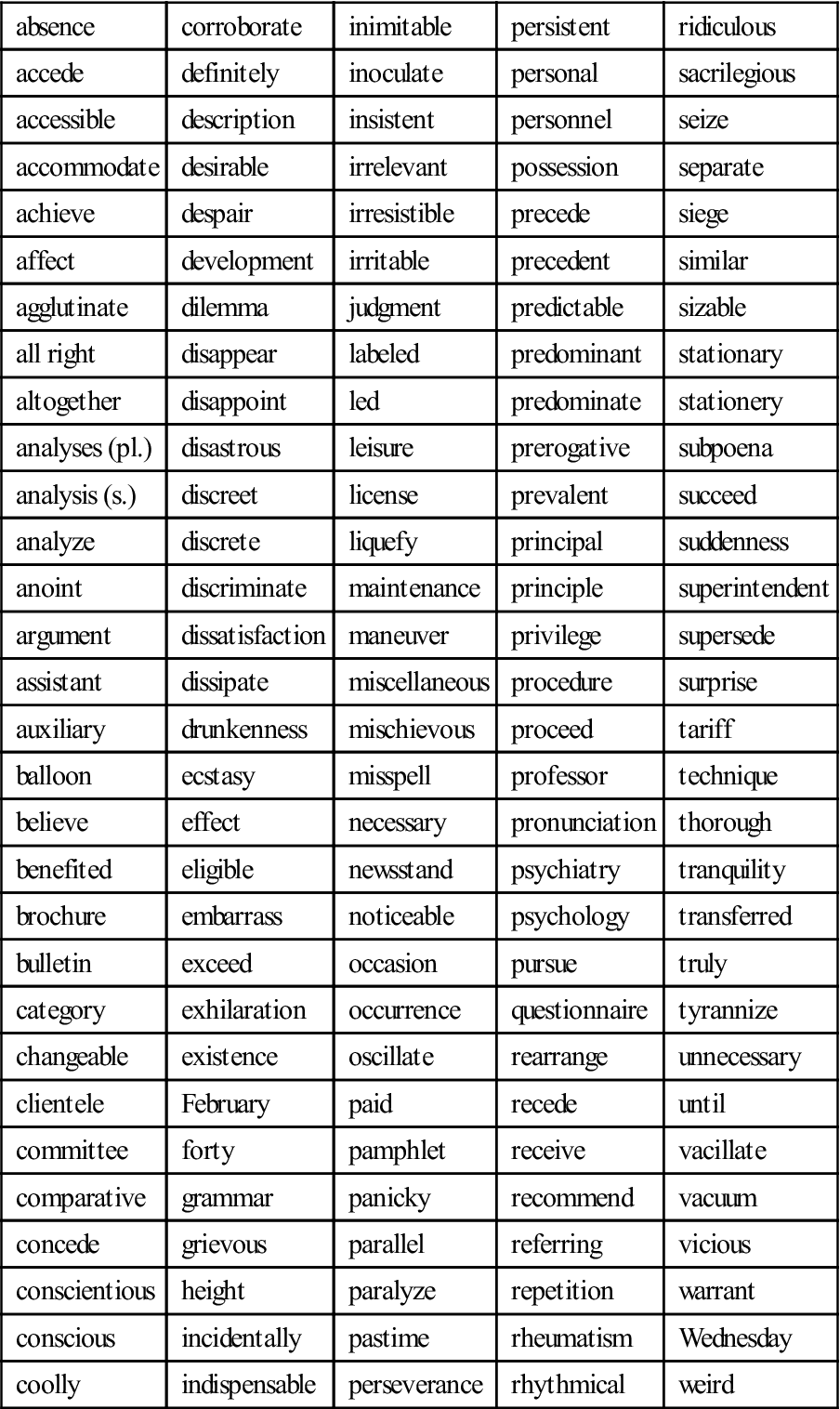
Writing Skills and Composing Tips
Grammar Review
Parts of Speech
Nouns.
Pronouns.
Verbs.
Adjectives.
Adverbs.
Prepositions.
Conjunctions.
Interjections.
Making Sense of Sentences
Types of Sentences.
Declarative:
She was the last person here.
Interrogatory:
Are we going to the fair today?
Imperative:
Clean your room before dinner.
Exclamatory:
I am so excited for you!
Sentence Structure.
Sentence Errors.
Personal Tools
Equipment and Supplies
Equipment
Computers
Copiers
Scanners
Printers
Supplies
Stationery
Sizes and Types of Letterhead Paper.
Standard or letter
8½ × 11 inches
Monarch or executive
8½ × 10½ inches
Baronial
5½ × 8½ inches
Legal
8½ × 14 inches
Continuation Pages.
Envelopes.
Letter Styles
Block Letter Style
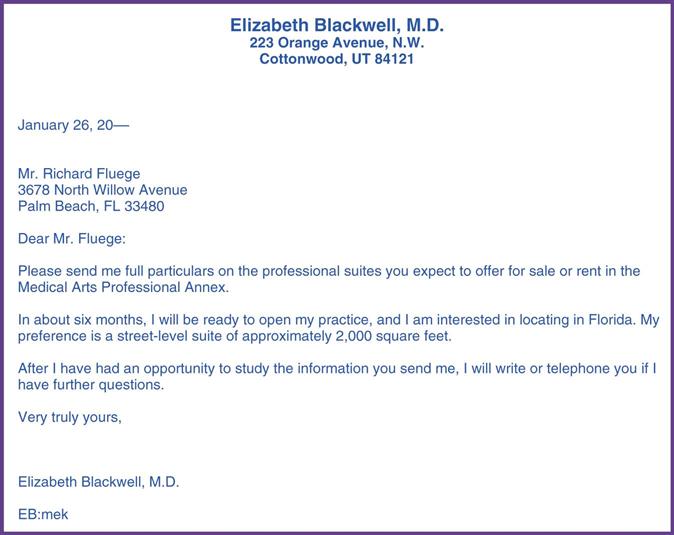
Modified Block Letter Style
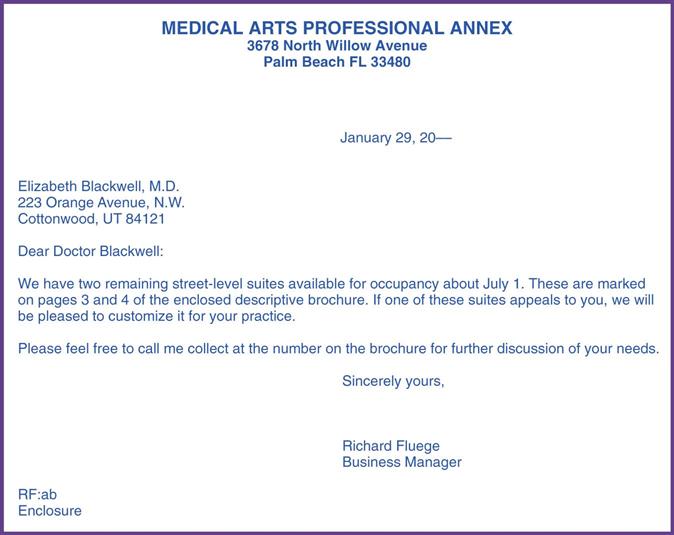
Modified Block Letter Style with Indented Paragraphs
Simplified Letter Style
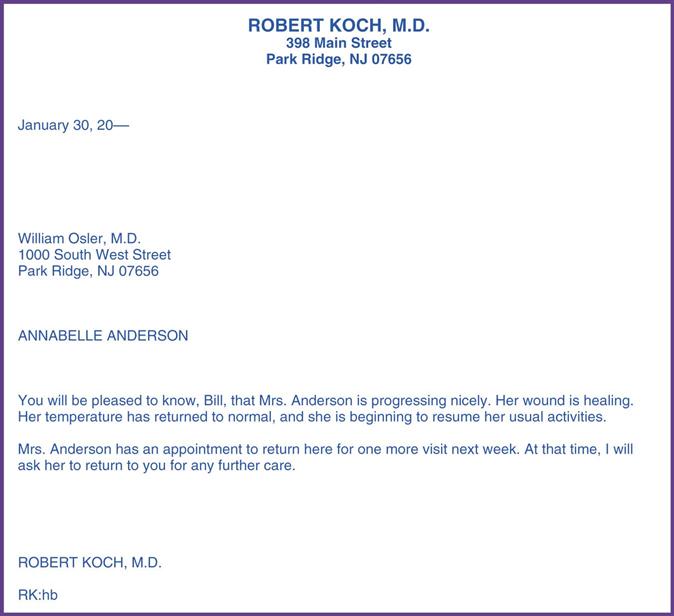
Types of Punctuation for Letter Styles
Spacing and Margins
The Parts of a Letter
Stay updated, free articles. Join our Telegram channel

Full access? Get Clinical Tree


